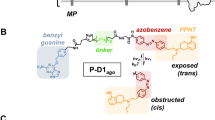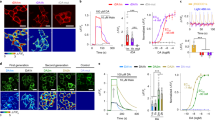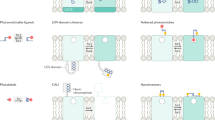Abstract
Most photoactivatable compounds suffer from the limitations of the ultraviolet wavelengths that are required for activation. We synthesized a neuroactive steroid analog with a fluorescent (7-nitro-2,1,3-benzoxadiazol-4-yl) amino (NBD) group in the β configuration at the C2 position of (3α,5α)-3-hydroxypregnan-20-one (allopregnanolone, 3α5αP). Light wavelengths (480 nm) that excite compound fluorescence strongly potentiate GABAA receptor function. Potentiation is limited by photodepletion of the receptor-active species. Photopotentiation is long-lived and stereoselective and shows single-channel hallmarks similar to steroid potentiation. Other NBD-conjugated compounds also generate photopotentiation, albeit with lower potency. Thus, photopotentiation does not require a known ligand for neurosteroid potentiating sites on the GABAA receptor. Photoactivation of a membrane-impermeant, fluorescent steroid analog demonstrates that membrane localization is critical for activity. The photoactivatable steroid silences pathological spiking in cultured rat hippocampal neurons and anesthetizes tadpoles. Fluorescent steroids photoactivated by visible light may be useful for modulating GABAA receptor function in a spatiotemporally defined manner.
This is a preview of subscription content, access via your institution
Access options
Subscribe to this journal
Receive 12 print issues and online access
$209.00 per year
only $17.42 per issue
Buy this article
- Purchase on Springer Link
- Instant access to full article PDF
Prices may be subject to local taxes which are calculated during checkout






Similar content being viewed by others
References
Zorumski, C.F., Mennerick, S., Isenberg, K.E. & Covey, D.F. Potential clinical uses of neuroactive steroids. Curr. Opin. Investig. Drugs 1, 360–369 (2000).
Gasior, M., Carter, R.B. & Witkin, J.M. Neuroactive steroids: potential therapeutic use in neurological and psychiatric disorders. Trends Pharmacol. Sci. 20, 107–112 (1999).
Belelli, D. & Lambert, J.J. Neurosteroids: endogenous regulators of the GABAA receptor. Nat. Rev. Neurosci. 6, 565–575 (2005).
Hess, G.P. Rapid chemical reaction techniques developed for use in investigations of membrane-bound proteins (neurotransmitter receptors). Biophys. Chem. 100, 493–506 (2003).
Dodt, H.U., Eder, M., Schierloh, A. & Zieglgansberger, W. Infrared-guided laser stimulation of neurons in brain slices. Sci. STKE 2002, PL2 (2002).
Shembekar, V.R., Chen, Y., Carpenter, B.K. & Hess, G.P. A protecting group for carboxylic acids that can be photolyzed by visible light. Biochemistry 44, 7107–7114 (2005).
Akk, G. et al. Neurosteroid access to the GABAA receptor. J. Neurosci. 25, 11605–11613 (2005).
Chang, Y., Xie, Y. & Weiss, D.S. Positive allosteric modulation by ultraviolet irradiation on GABA(A), but not GABA(C), receptors expressed in Xenopus oocytes. J. Physiol. (Lond.) 536, 471–478 (2001).
Leszkiewicz, D.N. & Aizenman, E. Reversible modulation of GABAA receptor–mediated currents by light is dependent on the redox state of the receptor. Eur. J. Neurosci. 17, 2077–2083 (2003).
Shu, H.J. et al. Cyclodextrins sequester neuroactive steroids and differentiate mechanisms that rate limit steroid actions. Br. J. Pharmacol. 150, 164–175 (2007).
Steinbach, J.H. & Akk, G. Modulation of GABAA receptor channel gating by pentobarbital. J. Physiol. (Lond.) 537, 715–733 (2001).
Phillipps, G.H. Structure-activity relationships in steroidal anaesthetics. J. Steroid Biochem. 6, 607–613 (1975).
Covey, D.F., Evers, A.S., Mennerick, S., Zorumski, C.F. & Purdy, R.H. Recent developments in structure-activity relationships for steroid modulators of GABAA receptors. Brain Res. Brain Res. Rev. 37, 91–97 (2001).
Woodward, R.M., Polenzani, L. & Miledi, R. Effects of steroids on γ-aminobutyric acid receptors expressed in Xenopus oocytes by poly(A)+ RNA from mammalian brain and retina. Mol. Pharmacol. 41, 89–103 (1992).
Wang, M. et al. 3β-hydroxypregnane steroids are pregnenolone sulfate-like GABAA receptor antagonists. J. Neurosci. 22, 3366–3375 (2002).
Majewska, M.D., Mienville, J.M. & Vicini, S. Neurosteroid pregnenolone sulfate antagonizes electrophysiological responses to GABA in neurons. Neurosci. Lett. 90, 279–284 (1988).
Park-Chung, M., Malayev, A., Purdy, R.H., Gibbs, T.T. & Farb, D.H. Sulfated and unsulfated steroids modulate γ-aminobutyric acidA receptor function through distinct sites. Brain Res. 830, 72–87 (1999).
Eisenman, L.N., He, Y., Fields, C., Zorumski, C.F. & Mennerick, S. Activation-dependent properties of pregnenolone sulfate inhibition of GABAA receptor–mediated current. J. Physiol. (Lond.) 550, 679–691 (2003).
Harrison, N.L., Vicini, S. & Barker, J.L. A steroid anesthetic prolongs inhibitory postsynaptic currents in cultured rat hippocampal neurons. J. Neurosci. 7, 604–609 (1987).
Wittmer, L.L. et al. Enantioselectivity of steroid-induced γ-aminobutyric acidA receptor modulation and anesthesia. Mol. Pharmacol. 50, 1581–1586 (1996).
Wei, W., Zhang, N., Peng, Z., Houser, C.R. & Mody, I. Perisynaptic localization of δ subunit–containing GABAA receptors and their activation by GABA spillover in the mouse dentate gyrus. J. Neurosci. 23, 10650–10661 (2003).
Dolmans, D.E., Fukumura, D. & Jain, R.K. Photodynamic therapy for cancer. Nat. Rev. Cancer 3, 380–387 (2003).
Morrell, M. Brain stimulation for epilepsy: can scheduled or responsive neurostimulation stop seizures? Curr. Opin. Neurol. 19, 164–168 (2006).
Mennerick, S., Que, J., Benz, A. & Zorumski, C.F. Passive and synaptic properties of neurons grown in microcultures and in mass cultures. J. Neurophysiol. 73, 320–332 (1995).
Bekkers, J.M. & Stevens, C.F. Excitatory and inhibitory autaptic currents in isolated hippocampal neurons maintained in cell culture. Proc. Natl. Acad. Sci. USA 88, 7834–7838 (1991).
Akk, G. et al. Neuroactive steroids have multiple actions to potentiate GABAA receptors. J. Physiol. (Lond.) 558, 59–74 (2004).
Acknowledgements
We thank A. Taylor, A. Benz and B.-W. Ma for technical help and laboratory members for advice and discussion. This work was supported by a gift from the Bantly Foundation (C.F.Z.) and by US National Institutes of Health grants NS44041 (L.N.E), GM 47969 (D.F.C., C.F.Z., A.S.E, J.H.S), AA12951 (C.F.Z.), NS54174, AA12952 and MH78823 (S.M.) and AA14707 (G.A.).
Author information
Authors and Affiliations
Contributions
Neurosteroid analogs were synthesized by C.W. and D.F.C. Experiments were performed by L.N.E., H.-J.S., G.A., B.D.M, G.J.K. and S.M., and the resulting data were analyzed by L.N.E., G.A., A.S.E., J.H.S., C.F.Z. and S.M. The manuscript was written by L.N.E., J.H.S., D.F.C., C.F.Z. and S.M.
Corresponding author
Ethics declarations
Competing interests
The authors declare no competing financial interests.
Supplementary information
Supplementary Fig. 1
Photoactivation of two additional 3α-OH NBD steroid conjugates. (PDF 703 kb)
Supplementary Table 1
The results of the analysis of open and closed duration. (PDF 36 kb)
Supplementary Video 1
Effects of C2-NBD 3α5αP and C2-NBD 3β5αP on tadpole swimming behavior after dim light and after 470 nm light exposure. (WMV 5107 kb)
Rights and permissions
About this article
Cite this article
Eisenman, L., Shu, HJ., Akk, G. et al. Anticonvulsant and anesthetic effects of a fluorescent neurosteroid analog activated by visible light. Nat Neurosci 10, 523–530 (2007). https://doi.org/10.1038/nn1862
Received:
Accepted:
Published:
Issue Date:
DOI: https://doi.org/10.1038/nn1862
This article is cited by
-
Robust photoregulation of GABAA receptors by allosteric modulation with a propofol analogue
Nature Communications (2012)



